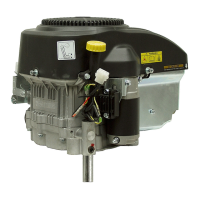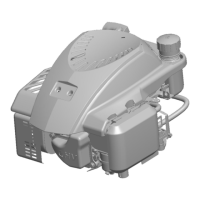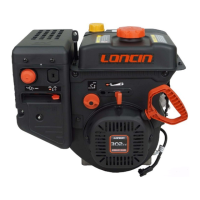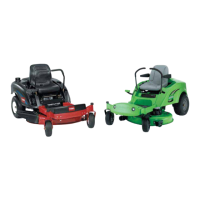39
ENGINE
General Information
In this section, we will cover both versions of the E
series en
ine. The DuraForce is a reed valve en
ine,
and the R tek is piston ported. The desi
n difference
affects the path which the incomin
fuel/air char
e
takes to
et to the firin
chamber.
Two-cycle en
ines have special advanta
es which
make their use more practical in certain applications.
Two-cycle en
ines are li
htwei
ht with an excellent
power-to-wei
ht ratio and can be operated in any
position, limited only by the carburetor and fuel supply
system. They are also notably easy to maintain and
service because of their uncomplicated desi
n.
Theory of Operation
Reed Valve Engine
The illustration below (see Fi
ure 64) shows what
happens inside the en
ine durin
one full crankshaft
revolution. Fuel intake, fuel i
nition, and the exhaust of
burned
ases all take place durin
a sin
le 360-de
ree
rotation of the crankshaft.
Fi
ure 64
3297-022-2
Be
innin
at a point where the top of the piston is just
below the exhaust port, the piston moves forward
toward the crankcase. As the transfer port is
uncovered, the fuel/air mixture stored in the
pressurized crankcase is forced into the combustion
chamber. (See Fi
ure 65.)
Fi
ure 65
3297-021-2
The crankshaft continues its rotation, and the piston
be
ins its travel toward the spark plu
. As it moves,
the piston seals off the transfer port first, then the
exhaust port. When both ports are sealed, the
remainin
travel compresses the air/fuel mixture to
prepare it for i
nition. The travel of piston towards the
spark plu
is called the compression stroke. (See
Fi
ure 65.)
The movement of the piston towards the spark plu
also has an important effect in the crankcase. Once
the transfer port is sealed, a vacuum is created in the
crankcase. This action pulls the reed valve open and
draws in a fresh char
e of fuel/air mixture.
Just before the piston reaches top dead center (TDC),
the spark plu
fires. When the en
ine is functionin
properly, the fuel/air mixture i
nites, causin
a burn
that occurs evenly throu
h the power stroke. The
piston chan
es direction and be
ins its travel towards
the crankcase.
NOTE: If the compression ratio is too hi
h, the fuel/air
mixture actually explodes before it is i
nited by the
spark plu
. This can be heard and is identified as
detonation (also called “knock”).
When the piston opens the exhaust port, hi
h-pressure
exhaust
ases exit the exhaust port. Further
movement of the piston towards the crankcase
uncovers the transfer port which allows a fresh char
e
of air/fuel mixture to enter the combustion chamber.
As the exhaust
ases continue to exit the exhaust port,
the en
ine is readied for another cycle.
A. Reed Valve Closed B. Exhaust Gases
A. Reed Valve Open

